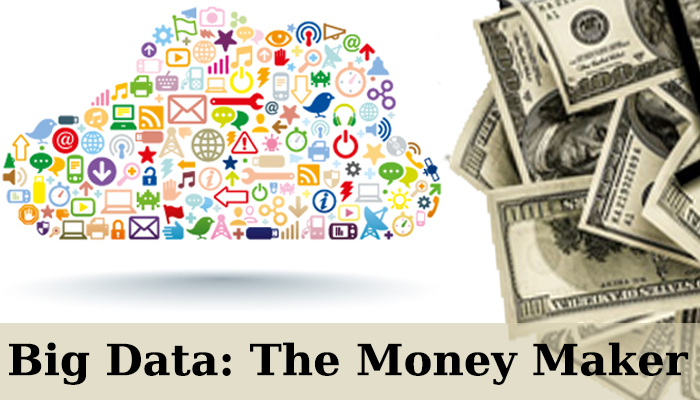Big Data: The Money Maker

- Reduces cost by optimizing business,
- Predicts potential hurdles and
- Restyle product as per the customer’s desire resulting in higher sales.
The trading of data can be accessed in two ways:
- Data of identifing Individuals: Here the data is personal so privacy regulations come into play.
- Anonymous data: Due to its anonymity it cannot be freely used as the privacy regulations and data protection is ambiguous in this scenario.
If the data is personal then the individual to whom the data belongs can waive of the privacy regulation for free or can charge revenue.
Big Data as the Money Maker
Big data is generating a handsome amount of revenue for the companies and opening different avenues for them to profit. Companies can create a business out of big data by:
- Contractual relationship
- Individual Business
- Partnership
Individual businesses have the advantages of:
- Economies of scale
- Strategy control
- Larger revenue
Partnership brings:
- Shared risks
- Partner’s skill advantage
In this data trading business company are in 2 states:
- Companies with a huge amount of existing data to generate revenue from
- Companies having valuable data, but not feasible for generating revenue
On the long road ahead companies in various fields will capitalized big data including those in
- Healthcare
- Manufacturing
- Consumer goods
- Energy
The money makers:
In big data there’s a seven primary profit pattern business model which states:
- Build to order
Products are customized as per the customer specification leading to higher satisfaction and greater revenue generation. The only downside is longer waiting period for customers due to the tailoring of the product and they don’t resell easily.
- Service Bundle
In this model several services are tied together as a bundle to give the customer a package deal. It helps cross sell and removes rivals from the market. The downside is the customer finds it difficult to access the value of the services individually.
- Plug and Play
Here a generalized product is made with all the necessary drivers and supports making it readily useable. But it leads to fewer profits as there is no personalization of the product.
- Pay per Use
Here the customer is allowed to access information of all kinds, but he needs to pay only for the service he uses. It has an unstable revenue and high cost of acquiring customers, which cuts out in profit.
- Commission
Here the business relation is steadier than pay per use model, as there is a continuous commission arrangement. To lower the variations generated the business has to do value addition to increase the customer payment.
- Value Exchange
In this situation there is an intermediary partner between the business and the customer who provides rebates. He is paid a certain commission by the company. By hitting a chosen interest group the company benefits on marketing investments, but the intermediary cost lowers the profits.
- Subscription
The customers have access to unlimited data for a fixed period for a certain amount of fee. It brings steady revenue and helps sell in different modes as well like up selling and cross selling. It brings lesser income than the pay per use model.
After studying these models it can be safely concluded that the model that caters to the mass market prevails. The companies need to market the newly launched products soon in the market to generate need and capitalize on it. As we move forward more and more opportunities will be capitalized by using these models individually or teamed up together, especially those secure a long term relationship with the customer.
The post is by Vaishnavi Agrawal loves pursuing excellence through writing and have a passion for technology. She has successfully managed and run personal technology magazines and websites.

























